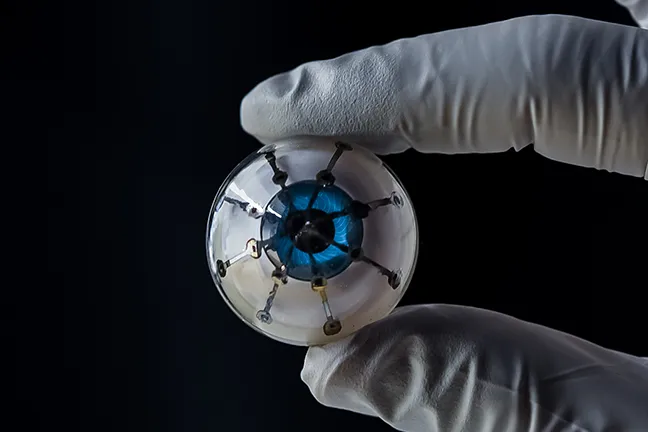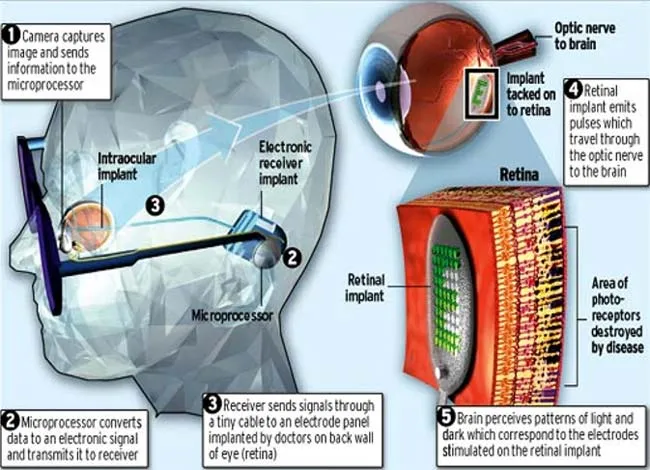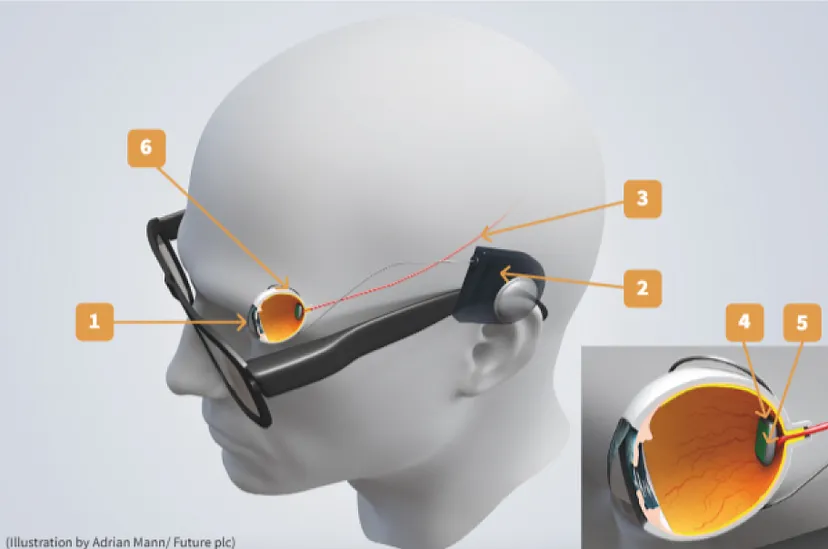Bionic eyes technology
Introduction: A New Dawn for Vision( Bionic Eyes Technology)
In a world where nearly 40 million individuals grapple with blindness and an additional 135 million with low vision, the pursuit of innovative solutions is at the forefront. Recent advancements in science and technology have birthed the revolutionary concept of bionic eyes, a beacon of hope for those grappling with sight loss due to injury, illness, or genetics.

The Dance of Light: Understanding Vision Mechanics
To comprehend the marvel of bionic eyes, one must first grasp the delicate dance of light within a healthy eye. Light enters through the pupil, focused by the lens onto the retina—a complex layer of light-sensitive tissue. Photoreceptors within the retina transform light into electrical signals, creating a visual narrative sent to the brain via the optic nerve.
Bridging the Abyss: The Emergence of Bionic Eye Technology
However, diseases often interrupt this delicate system, damaging the retina and obstructing sight. This is where bionic eye technology steps in, marking a historic milestone in 2009 with the Argus II trial in the U.K. This pioneering effort paved the way for subsequent developments, including a groundbreaking 2021 computer model by USC mimicking the human retina, hinting at a vibrant and clearer future for bionic eyes.

Triumphs in Trials: From Sheep to Human Trials
Recent successes in sheep trials of the Phoenix99 bionic eye by scientists at the University of Sydney and UNSW offer a glimmer of hope. Anticipating safe and lasting implantation in humans for many years, the challenge lies in reducing the bulkiness of the technology. Innovative power solutions, such as the low-power system developed by scientists at the Harbin Institute of Technology, underscore the race to enhance bionic eye efficiency.
Peeling Back the Layers: The Intricacies of Bionic Eye Technology
To truly appreciate the significance of bionic eyes, one must unravel the intricate translation of images for the human brain. An interactive image guides us through the process, from the artificial pupil capturing images, to a receiver processing data behind the ear, and an implant filling the void in the retina. This enables patients to perceive light, movement, and shapes, redefining the boundaries of vision restoration.
Hope Amidst Darkness: Tackling Vision-Destroying Illnesses
A myriad of conditions, from age-related macular degeneration to genetic disorders like Retinitis Pigmentosa, cause sight deterioration. Bionic eyes emerge as a beacon of hope, “filling in the blanks” between the retina and the brain’s visual cortex, particularly in conditions affecting the retina.
Real Stories, Real Impact: Keith Hayman’s Bionic Eye Journey
In 2009, Keith Hayman, a grandfather battling retinitis pigmentosa, became the inaugural recipient of a bionic eye. His transformative journey echoes the power of this technology, enabling him to see his grandchildren—a poignant testament to the tangible impact on real lives.
Conclusion: Shaping a World of Sight
In the evolving landscape of bionic eyes, each development brings us closer to a world where visual impairments are not insurmountable. These technological marvels are poised to redefine the boundaries of what’s possible for the visually impaired, offering a renewed sense of hope.
FAQs
- How long does the implantation process for bionic eyes take?
- While the process duration varies, ongoing advancements suggest shorter, more efficient procedures.
- Can bionic eyes completely restore normal vision?
- Significant progress has been made, but complete restoration remains a goal for ongoing research.
- Are there risks associated with bionic eye surgery?
- Like any surgery, there are inherent risks, but ongoing research aims to minimize these risks.
- How affordable is bionic eye technology?
- Cost remains a challenge, but ongoing research endeavors aim to make this technology more accessible.
- What other eye conditions could bionic eyes potentially treat?
- Bionic eyes show promise in addressing a spectrum of eye conditions, from degenerative diseases to injuries.

